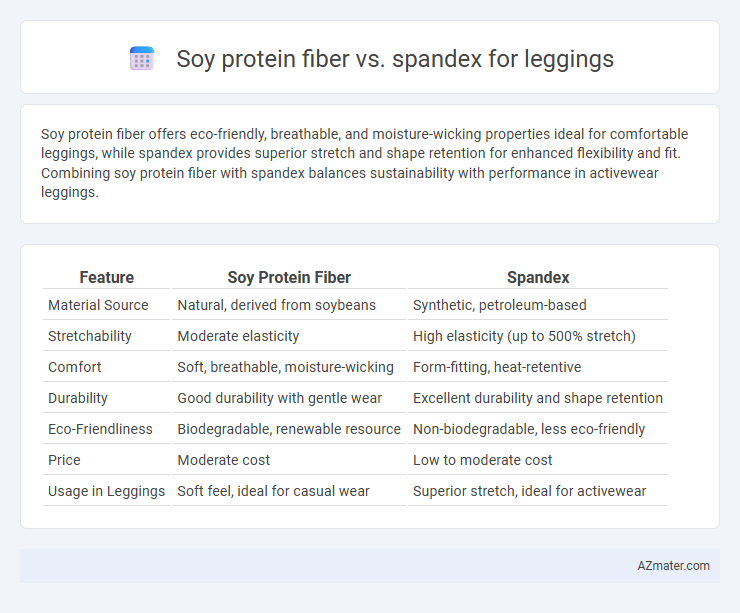Soy protein fiber offers eco-friendly, breathable, and moisture-wicking properties ideal for comfortable leggings, while spandex provides superior stretch and shape retention for enhanced flexibility and fit. Combining soy protein fiber with spandex balances sustainability with performance in activewear leggings.
Table of Comparison
| Feature | Soy Protein Fiber | Spandex |
|---|---|---|
| Material Source | Natural, derived from soybeans | Synthetic, petroleum-based |
| Stretchability | Moderate elasticity | High elasticity (up to 500% stretch) |
| Comfort | Soft, breathable, moisture-wicking | Form-fitting, heat-retentive |
| Durability | Good durability with gentle wear | Excellent durability and shape retention |
| Eco-Friendliness | Biodegradable, renewable resource | Non-biodegradable, less eco-friendly |
| Price | Moderate cost | Low to moderate cost |
| Usage in Leggings | Soft feel, ideal for casual wear | Superior stretch, ideal for activewear |
Understanding Soy Protein Fiber: A Sustainable Alternative
Soy protein fiber, derived from soybean residues, provides a sustainable and eco-friendly alternative to synthetic fibers like spandex in leggings. This biodegradable fiber offers excellent moisture absorption, breathability, and softness, enhancing comfort without compromising flexibility or durability. Incorporating soy protein fiber in leggings reduces environmental impact while maintaining the stretch and shape retention qualities essential for activewear.
What Is Spandex? Origins and Key Features
Spandex, also known as elastane, is a synthetic fiber developed in 1958 by DuPont, prized for its exceptional elasticity and durability in activewear like leggings. Derived from polyurethane, spandex can stretch up to 500% of its original length, offering excellent shape retention and comfort during movement. Its lightweight, moisture-wicking properties make it a preferred choice in performance garments compared to natural fibers such as soy protein fiber, which emphasizes sustainability but lacks comparable stretch and resilience.
Comfort and Fit: Comparing Soy Protein Fiber and Spandex
Soy protein fiber offers a soft, breathable texture that enhances comfort in leggings by providing moisture-wicking and hypoallergenic properties. Spandex delivers superior elasticity and shape retention, ensuring a snug fit that moves with the body during active use. Leggings blending soy protein fiber with spandex combine comfort and flexibility, resulting in breathable, form-fitting apparel ideal for prolonged wear.
Breathability and Moisture Management in Leggings
Soy protein fiber leggings offer superior breathability due to their natural moisture-wicking properties and enhanced airflow, making them ideal for maintaining comfort during extended wear. In contrast, spandex provides excellent stretch and shape retention but tends to trap heat and moisture, reducing overall breathability. Combining soy protein fiber with spandex can optimize leggings by balancing moisture management with flexibility, ensuring both comfort and durability.
Stretch and Recovery: Performance Differences
Soy protein fiber offers moderate stretch with excellent moisture-wicking properties, providing a natural alternative that enhances comfort but has limited recovery compared to Spandex. Spandex excels in stretchability, offering up to 500% elongation and superior shape retention, making it ideal for leggings requiring high flexibility and bounce-back performance. The blend of Spandex with other fibers ensures optimal fit, durability, and sustained elasticity, outperforming soy protein fiber in recovery and stretch resilience.
Durability and Longevity of Soy Protein Fiber vs Spandex
Soy protein fiber leggings offer excellent durability due to their natural toughness and resistance to wear, maintaining fabric integrity through multiple washes. Spandex provides superior elasticity but can degrade faster with frequent stretching, reducing overall longevity in high-stress areas. Choosing soy protein fiber enhances legging lifespan, ensuring longer-lasting shape retention and resistance to abrasion compared to spandex-blended options.
Skin Sensitivity and Hypoallergenic Properties
Soy protein fiber offers superior skin sensitivity benefits due to its natural protein structure, which closely mimics human skin, reducing irritation and promoting breathability in leggings. This fiber is hypoallergenic, making it an excellent choice for individuals with sensitive skin or allergies. In contrast, spandex, while providing excellent stretch and durability, may cause irritation for sensitive skin because it is a synthetic material and less breathable.
Eco-Friendliness: Environmental Impact Assessment
Soy protein fiber leggings offer significant eco-friendliness due to their biodegradability and renewable plant-based origins, resulting in lower carbon emissions and reduced reliance on synthetic materials. Spandex, derived from non-renewable petrochemicals, contributes to environmental pollution through energy-intensive production processes and non-biodegradable waste accumulation. Choosing soy protein fiber over spandex supports sustainable fashion by minimizing ecological footprint and promoting circular textile life cycles.
Cost Factors: Price Comparison and Affordability
Soy protein fiber leggings generally cost more than spandex leggings due to the sustainable production processes and natural origins of soy protein fiber, which increase manufacturing expenses. In contrast, spandex is a synthetic fiber produced at a lower cost, making spandex leggings more affordable for mass-market consumers. Price comparisons show that soybean-based leggings may range from 20-30% higher in retail price compared to equivalent spandex leggings, impacting overall affordability for budget-conscious buyers.
Ideal Use Cases: Choosing Between Soy Protein Fiber and Spandex
Soy protein fiber leggings excel in breathability and eco-friendliness, making them ideal for yoga, light workouts, and casual wear where comfort and sustainability are prioritized. Spandex leggings offer superior stretch, durability, and shape retention, perfect for high-intensity activities like running, gym workouts, and dance. Selecting between soy protein fiber and spandex depends on balancing the needs for natural softness and environmental impact versus elasticity and performance.

Infographic: Soy protein fiber vs Spandex for Legging
 azmater.com
azmater.com